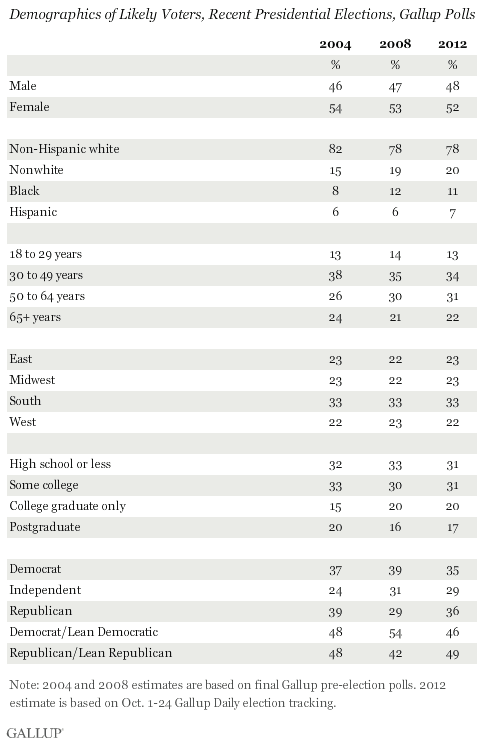PRINCETON, NJ -- The composition of the electorate for the 2012 presidential election is looking quite similar to what it was in 2008 as well as 2004, according to an analysis of the demographics of Gallup's likely voter sample since Oct. 1. Thus, key elements of President Obama's electoral coalition, such as racial minorities, women, young adults, and postgraduates will likely turn out at rates similar to those in 2008.

The demographics of the likely voter sample give an estimate of the relative influence each subgroup will have on the overall vote due to its voter turnout. The figures in the accompanying graph are derived from Gallup survey estimates, which are different from and may not match figures from exit poll surveys that use different methods and different questions to measure these demographic variables.
Gallup identifies likely voters using a series of seven questions that ask about current voting intentions and past voting behavior. The resulting sample of likely voters has proven to give a generally accurate prediction of the final election outcome. For example, in 2004, Gallup's final likely voter estimate (before undecideds were allocated to the candidates) showed George W. Bush with a two-percentage-point advantage over John Kerry in an election Bush won by just over two points. And Gallup's final 2008 estimate showed Barack Obama outpolling John McCain by 11 points, a slight overestimate of Obama's seven-point margin of victory.
The lack of change in the composition of the electorate in recent years is not unexpected, given that there are limits on how great a share of the electorate a subgroup can represent -- mainly its share of the overall U.S. adult population. For example, if 12% of all Americans are black, turnout among blacks would have to be proportionately greater than that of other racial groups for their share of the electorate to exceed 12%. The fact that 11% of likely voters this year are black indicates that turnout among blacks may be slightly less than among other racial groups.
To the extent the electorate looks different now compared with 2004 or 2008, those changes may have as much to do with changes in the larger national adult population as with differential turnout by group this year.
For example, the largest changes in the composition of the electorate compared with the last presidential election concern the partisan affiliation of voters. Currently, 46% of likely voters identify as Democrats or lean Democratic, compared with 54% in 2008. But in 2008, Democrats enjoyed a wide 12-point advantage in party affiliation among national adults, the largest Gallup had seen in at least two decades. More recently, Americans have been about as likely to identify as or lean Republican as to identify as or lean Democratic. Consequently, the electorate has also become less Democratic and more Republican in its political orientation than in 2008. In fact, the party composition of the electorate this year looks more similar to the electorate in 2004 than 2008.
Additionally, the percentage of nonwhite voters, now 20%, has risen significantly since 2004 (15%) -- though it is similar to 2008's 19% -- largely due to the proportionately greater growth of the nonwhite population in the United States over the past decade.
Implications
Thus, given the relatively similar demographic composition of the 2012 and 2008 electorates, the election's outcome may hinge more on how groups vote rather than to what extent they will vote. And most groups are currently less likely to support Obama now than they were in 2008. However, Obama's seven-point margin of victory in the 2008 election leaves him considerable breathing room to lose electoral support yet still win the election.
At this point, though, Gallup Daily tracking of likely voter preferences suggests Obama has lost more support than he could afford to, given his current 50% to 47% deficit to his Republican challenger, Mitt Romney. To close that gap in the final weeks of the campaign, Obama would need to have subgroups favorable to him, such as blacks or young adults, turn out at rates that match or exceed those of groups less favorable to him, or to increase his support among key subgroups even if their turnout remains the same.
Track every angle of the presidential race on Gallup.com's Election 2012 page.
Survey Methods
Results for this Gallup poll are based on telephone interviews conducted Oct. 1-24 2012, on the Gallup Daily election tracking survey, with a random sample of 9,424 likely voters, aged 18 and older, living in all 50 U.S. states and the District of Columbia.
For results based on the total sample of likely voters, one can say with 95% confidence that the maximum margin of sampling error is ±1 percentage point.
Margins of error for subgroups will be higher.
Interviews are conducted with respondents on landline telephones and cellular phones, with interviews conducted in Spanish for respondents who are primarily Spanish-speaking. Each sample includes a minimum quota of 250 cell phone respondents and 250 landline respondents per 500 national adults, with additional minimum quotas among landline respondents by region. Landline telephone numbers are chosen at random among listed telephone numbers. Cell phone numbers are selected using random-digit-dial methods. Landline respondents are chosen at random within each household on the basis of which member had the most recent birthday.
Samples are weighted by gender, age, race, Hispanic ethnicity, education, region, adults in the household, population density, and phone status (cell phone only/landline only/both, cell phone mostly, and having an unlisted landline number). Demographic weighting targets are based on the March 2011 Current Population Survey figures for the aged 18 and older non-institutionalized U.S. population. All reported margins of sampling error include the computed design effects for weighting.
In addition to sampling error, question wording and practical difficulties in conducting surveys can introduce error or bias into the findings of public opinion polls.
For more details on Gallup's polling methodology, visit www.gallup.com.
